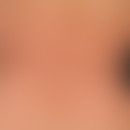Synonym(s)
DefinitionThis section has been translated automatically.
Sensitization by mold allergens. By analysing and classifying the allergens (see below), the diagnosis of mould allergy is much more precise than before. A. alternata has isolated 16 allergens so far, many of them enzymes (Alt a 4 (disulfide isomerase), Alt a 6 (enolase), Alt a 8 (mannitol dehydrogenase), Alt a 10 (alcohol dehydrogenase), Alt a 13 (glutathione-S-transferase), Alt a MnSOD (Mn superoxide dismutase). Others have structural and regulatory functions. Alt a 5 and Alt a 12 compress the structure of large ribosomal subunits and regulate translations, Alt a TCTP acts like a cytokine. The function of several allergens is still completely unknown (Alt a 1, Alt a 2, Alt a 9 and Alt a 70 kDa).
ClassificationThis section has been translated automatically.
Classification and molecular biological classification of common mould allergens modified according to "WHO/IUIS, Allergen Nomenclature Sub-committee".
Alternaria
- Alt a 1
- Alt a 3 Heat shock protein
- Alt a 4 Disulfide isomerase
- Alt a 5 Ribosomal protein P2
- Alt a 6 Enolase
- Alt a 7 YCP4 protein
- Alt a 8 Mannitol dehydrogenase
- Alt a 10 Aldehydes dehydrogenase
- Alt a 12 Acid ribosomal protein
- Alt a 13 Glutathione S-transferase
- Alt a 14 Manganese superoxide dismutase
- Alt a 15 Serine protease
Aspergillus flavus (fungus)
- Asp fl 13 Alkaline serine protease
- Aspergillus fumigatus (fungus)
- Asp f 1 Mitogillin family
- Asp f 2
- Asp f 3 Peroxysomal protein
- Asp f 4
- Asp f 5 Metalloprotease
- Asp f 6 Mn superoxide dismutase
- Asp f 7
- Asp f 8 Ribosomal protein
- Asp f 9
- Asp f 10 Aspartate protease
- Asp f 11 Peptidyl-prolyl isomerase
- Asp f 12 Heat shock protein P90
- Asp f 13 Alkaline serine protease
- Asp f 15
- Asp f 16
- Asp f 17
- Asp f 18 Vacuolar serine protease
- Asp f 22 Enolase
- Asp f 23 L3 ribosomal protein
- Asp f 27 Cyclophilin
- Asp f 28 Thioredoxin
- Asp f 29 thioredoxin
- Asp f 34 PhiA cell wall protein
Aspergillus niger
- Asp n 14 Beta-xylosidase
- Asp n 18 Vacuolar serine protease
- Asp n 25 3-phytase B
Aspergillus oryzae
- Asp o 13 Alkaline serine protease
- Asp o 21 TAKA-amylase A
Aspergillus versicolor
- Asp v 13 Extracellular alkaline serine protease
Cladosporium cladosporioides
- Cla c 9 Vacuolar serine protease
- Cla c 14 Transaldolase
Cladosporium herbarum
- Cla h 2
- Cla h 5 Acid ribosomal protein P2
- Cla h 6 Enolase
- Cla h 7 YCP4 protein
- Cla h 8 Mannitol dehydrogenase
- Cla h 9 Vacuolar serine protease
- Cla h 10 Aldehydes dehydrogenase
- Cla h 12 Acid ribosomal protein P1
Curvularia lunata (synonym: Cochliobolus lunatus)
- Cur l 1 Serine protease
- Cur l 2 Enolase
- Cur l 3 Cytochrome c
- Cur l 4 Vacuolar serine protease
Epicoccum purpurascens (Soil fungus)
- Epi p 1 Serine protease
Fusarium culmorum (N.A.)
- Fus c 1 Ribosomal protein P2
- Fus c 2 Thioredoxin-like protein
Fusarium proliferatum
- Fus p 4 Transaldolase
- Fus p 9 Vacuolar serine protease
Penicillium brevicompactum
- Pen b 13 Alkaline serine protease
- Pen b 26 Acidic ribosomal prot. P1
Penicillium chrysogenum
- Pen ch 13 Alkaline serine protease
- Pen ch 18 Vacuolar serine protease
- Pen ch 20 N-acetyl-glucosaminidas
- Pen ch 31 Calreticulin
- Pen ch 33
- Pen ch 35 Transaldolase
Penicillium citrinum
- Pen c 3 Peroxysomal membrane protein
- Pen c 13 Alkaline serine protease
- Pen c 19 Heat shock protein
- Pen c 22 Enolase
- Pen c 24 elongation factor 1 beta
- Pen c 30 Catalase
- Pen c 32 Pectate lyase
Penicillium crustosum
- Pen cr 26 60S acidic ribosomal phosphoprotein P1
Penicillium oxalicum
- Pen o 18 Vacuolar serine protease
Stachybotrys chartarum
- Sta c 3 Extracellular alkaline Mg-dependent exodesoxyribonuclease
Trichophyton rubrum
- Tri r 2 Putative secreted alkaline protease Alp1
- Tri r 4 Serine protease
Trichophyton tonsurans
- Tri t 1
- Tri t 4 Serine protease
You might also be interested in
ClinicThis section has been translated automatically.
Clinically, an allergy to mould is difficult to detect. Most often, a mould allergy develops aerogenically by inhalation of the spores. In this respect, the allergic phenomena of the respiratory tract are the most common initial symptoms.
The patient's symptoms must be precisely characterised in terms of time and clinical symptoms (keeping a symptom diary).
High aerogenic spore concentrations of moulds are particularly noticeable from May to October. Alternaria and Cladosporium spores are more frequently observed in July and August.
DiagnosisThis section has been translated automatically.
By analysing and classifying the allergens (see below), the diagnosis of mould allergy is much more precise than before. A. alternata has isolated 16 allergens so far, many of them enzymes (Alt a 4 (disulfide isomerase), Alt a 6 (enolase), Alt a 8 (mannitol dehydrogenase), Alt a 10 (alcohol dehydrogenase), Alt a 13 (glutathione-S-transferase), Alt a MnSOD (Mn superoxide dismutase). Others have structural and regulatory functions. Alt a 5 and Alt a 12 compress the structure of large ribosomal subunits and regulate translations, Alt a TCTP acts like a cytokine. The function of several allergens is still completely unknown (Alt a 1, Alt a 2, Alt a 9 and Alt a 70 kDa).
Diet/life habitsThis section has been translated automatically.
Information for patients with mould allergy
- Regular shock ventilation of the apartment.
- No humidifiers on radiators.
- Mould stains behind cupboards, wood panelling and on wallpaper are indications of mould infestation.
- Any water damage that has occurred should be carefully repaired.
- No indoor plants (especially in hydroponics).
- Do not leave kitchen waste lying around
- Store fruit and vegetables only in the refrigerator.
- Clean the refrigerator regularly.
- People who are highly sensitized to mold can also react to food if it is already moldy (vegetables, fruit) or if it is made from raw materials containing mold (fruit juices, beer, wine). Symptoms are: migraine, abdominal pain, diarrhoea and vomiting.
- No gardening work (there is a high probability of mould colonies on cut parts of plants or compost).
- Do not mow the lawn, as this will stir up a large number of mould spores.
Note(s)This section has been translated automatically.
Diagnostics for indoor mould exposure (revised version of the UBA mould guideline; cited according to A. Wiesmüller 2018);
1.) Mould infestation to a relevant extent must not be tolerated in interiors for precautionary reasons. The assessment of the extent of damage is carried out according to the "Guidelines for the prevention, investigation, evaluation and remediation of indoor mould growth" issued by the Federal Environment Agency.
2.) The most important measures for indoor mould exposure are clarification of the cause and proper remediation in accordance with mould remediation guidelines.
3.) Mould measurements in the interior from medical indication are rarely useful. As a rule, in the case of visible mould infestation, both a quantitative and qualitative determination of the mould species can be dispensed with. Rather, the causes of the infestation must be clarified and then the infestation and its primary causes must be eliminated.
4.) Mold-expositions can lead generally to irritations of the mucous membranes (mucous membrane irritation, MMI) smell-effects and Befindlichkeitsstörungen.
5.) Special clinical pictures with mold fungus exposition concern allergies and mold fungus infections
6.) It is a medical task to objectify in cases of a suspected connection of moisture damage or mould in indoor rooms with gastrointestinal or renal diseases, reproductive disorders, teratogenicity or cancer.
7.) Risk groups requiring special protection are:
a) persons under immunosuppression according to the classification of the Commission for Hospital Hygiene and Infection Prevention (KRINKO) at the Robert Koch Institute (RKI).
b) Persons with mucoviscidosis (cystic fibrosis)
c) Persons with bronchial asthma
8.) The risk for the development of asthma (change of floor) is increased with:
a) patients with allergic rhinoconjunctivitis
(b) patients with allergic rhinosinusitis
(c) patients with atopy
9.) Probably all moulds are suitable to cause sensitisation and allergies. Compared to other environmental allergens, the allergenic potential is estimated to be lower.
10.) Atopiker (persons with a tendency to react hypersensitively to the contact with environmental substances - with allergic rhinitis, allergic asthma or atopical dermatitis) often show IgE-antibodies also against molds as polysensitized persons, which however does not necessarily have a disease value.
11.) Core elements of allergy diagnostics are the medical history, skin testing (prick test) and serological examinations (in vitro) of:
- specific IgE antibodies in the case of type I sensitization or
- specific IgG antibodies in the case of exogenous allergic alveolitis (very rare in the case of non-workplace-related indoor exposure)
and provocation testing.
12.) The detection of specific IgE means that there is a specific sensitisation to corresponding allergens. However, just like a positive reaction in the skin test, this is not the same as a clinically relevant allergy.
13.) Negative in-vitro and in-vivo test results do not exclude a sensitization or allergy to mold(s).
14.) The determination of IgG antibodies in connection with the diagnosis of a mold allergy of the immediate type (type I allergy) has no diagnostic significance and is therefore not recommended.
15.) Lymphocyte transformation tests (LTT) for mould fungi are not indicated as diagnostic procedures.
16.) Infections caused by moulds are rare and are most likely to be inhaled. In practice, the importance of Aspergillus fumigatus as the most important mycosis pathogen is highest of the 460 moulds classified in risk groups 2 and 3 according to TRBA (Technical Rules for Biological Agents). Affected are predominantly persons with local and general immune deficiency.
17.) Core elements of mould infection diagnostics are microbiological and radiological procedures.
18.) Persons allergic to mould and persons with diseases that weaken the immune system should be well informed about the dangers of mould exposure indoors and about measures for prevention. They should minimize such exposure.
LiteratureThis section has been translated automatically.
- Behbod B et al (2014) Asthma & Allergy Development: Contrasting Influences of Yeasts & Other Fungal Exposures. Clin Exp Allergy PubMed PMID: 25200568.
- Jin J et al (2014) The prevalence of increased serum IgE and Aspergillus sensitization in patients with COPD and their association with symptoms and lung function. Respir Res 29:130
- Kespohl S et al (2013) Biochemical and immunological analysis of mould skin prick test solution: current status of standardization. Clin Exp Allergy 43:1286-1296
- Kustrzeba-Wójcicka I et al (2014) Alternaria alternata and Its Allergens: a Comprehensive Review. Clin Rev Allergy Immunol 47:354-365
- Namvar S et al (2014) Aspergillus fumigatus proteases, Asp f 5 and Asp f 13, are essential for airway inflammation and remodelling in a murine inhalation model. Clin Exp Allergy PubMed PMID: 25270353
- Natarajan S et al (2014) Allergic bronchopulmonary aspergillosis: A clinical review of 24 patients: Are we right in frequent serologic monitoring? Ann Thorac Med 9:216-220
- Snelgrove RJ et al (2014) Alternaria-derived serine protease activity drives IL-33-mediated asthma exacerbations. J Allergy Clin Immunol 134:583-5
- Wiesmüller A et al (2018) Medical-clinical diagnostics for indoor mould exposure. skin 29: 22-27
Outgoing links (1)
Immunosuppression risk groups;Disclaimer
Please ask your physician for a reliable diagnosis. This website is only meant as a reference.




